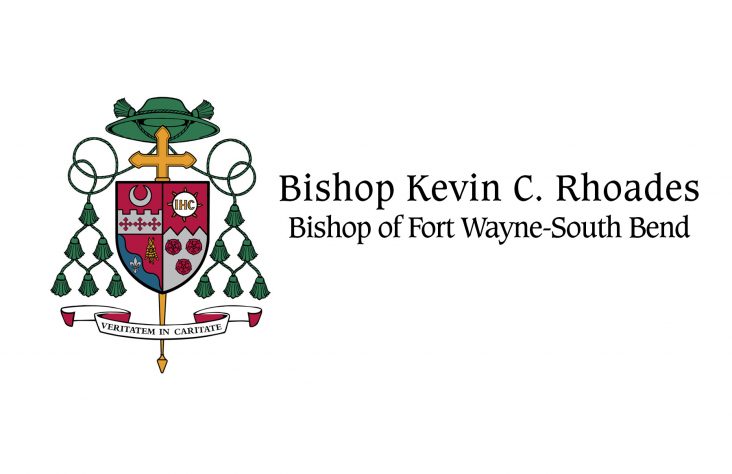November 6, 2012 // Uncategorized
Fort Wayne students called to be saints at all-schools Mass
Bishop Rhoades celebrates Mass with Fort Wayne area students
By Tim Johnson
FORT WAYNE — “There’s the new saint. There’s the new saint.” That’s the phrase Noelle Voglewede of St. Louis Academy, New Haven, heard as she made her way into the Allen County War Memorial Coliseum on a blustery Oct. 30 for the all-schools Mass celebrated by Bishop Kevin C. Rhoades. Noelle was dressed as St. Kateri Tekakwitha, a Native North American who was just canonized Oct. 21 by Pope Benedict XVI at the Vatican.
Voglewede was just one of eight St. Kateri Tekakwitha-garbed fourth graders who were called to the stage to be quizzed by Bishop Rhoades during his homily.
Bishop Rhoades also asked for those dressed as martyrs on the main floor to rise as he went down to the floor to quiz the students about their chosen saint and hero. St. Lucy, St. Agnes and St. Timothy were among the martyrs discussed in the homily.
“The Church is more than us,” Bishop Rhoades told the schoolchildren at the coliseum. The Church includes the brothers and sisters in the glory of heaven. Those saints, he said, are honored on Nov. 1, All Saints Day.
“They pray for us. They intercede for us,” Bishop Rhoades said.
“The Church also includes those who died and are being purified,” he added. Their feast day is Nov. 2, the feast of All Souls. “They are not ready to see God because of remnants of sins. They are in purgatory and are the suffering Church.”
The canonized saints are “great witnesses of faith and heroes for us,” Bishop Rhoades said. “They teach us by their example.”
Bishop Rhoades asked each of the eight girls who chose St. Kateri Tekakwitha to share something about the new saint.
“She is a role model,” the first girl told the bishop.
“She had smallpox,” the second girl said. Bishop Rhoades explained how smallpox took the lives of her parents and left Kateri with scars.
“She is the patron saint for children who lost parents,” the third girl said.
“At the moment she died, the smallpox marks disappeared from Kateri’s face,” the fourth student said.
Kateri was raised by an uncle who was not Catholic and she was criticized for her Christian faith, the bishop noted. Kateri wanted to give her life to Jesus rather than marry
and was baptized at the age of 20. She died when she was only 24.
Kateri lived near Auriesville, N.Y., and was born just eight years after the death of the eight North American Jesuit martyrs, whose shrine is also in Auriesville.
“The blood of the martyrs is the seed of Church,” Bishop Rhoades quoted. And years later, another saint is recognized from the area.
“All of us are called to be saints,” Bishop Rhoades said.
He encouraged the students to speak with God in prayer and to allow some silence to hear His response.
Bishop Rhoades also reflected upon the day’s Gospel about the rich man who obeyed the Commandments but did not want to sell his material goods and follow Jesus.
“He went away sad,” Bishop Rhoades noted.
He encouraged the young people, “When we follow Jesus, we experience great joy. … Make Him the most important person in our lives.”
He encouraged those of all ages, the church militant, to answer the call to be saints. “You are called to serve Him with your life,” Bishop Rhoades said, whether that be a religious vocation or as a holy husband and wife.
Students from the area brought offertory gifts of food to the Mass.
The Bishop Dwenger High School choir led the music for the Mass, and high school students from Bishop Dwenger and Bishop Luers coordinated parking and ushering services.
After Mass, Elias Hilger of St. Vincent de Paul School in Fort Wayne told Today’s Catholic he chose the saint he was named after. Hilger said St. Elias was a Spanish martyr and priest and explained that the saint was fed by ravens.
Hilger said the fourth graders at St. Vincent enjoyed being interviewed by their first-grade “spirit pals” and relaying stories about their saints.
Stephen Weissert, of St. Jude School, Fort Wayne, chose St. Stephen as his hero. “St. Stephen,” Weissert said, “was the first Christian martyr and was stoned to death.”
Weissert passionately described his saint and said he knew his facts well because they could not use their notes during their report in class. They had to know it “from their heart,” he said.
Weissert explained the reeds he carried: “They symbolize flexibility and strength because his soul would not bend under the pressure of his trials.”
He added, “I am very excited to represent my school down on the floor this year.”
Michelle Castleman contributed to this article.
The best news. Delivered to your inbox.
Subscribe to our mailing list today.





